Bangarang/it: Difference between revisions
(Importing a new version from external source) |
(Importing a new version from external source) |
||
| Line 47: | Line 47: | ||
== Open Source == | == Open Source == | ||
'''Bangarang''' | '''Bangarang''', una parola giamaicana per rumore, caos e disordine, è un software open source sviluppato da volontari. Segui il [http://bangarangkde.wordpress.com/blog/ blog del progetto]. Se desideri partecipare contribuendo con codice, traduzioni, grafica o idee, per favore guarda la [http://gitorious.org/bangarang pagina del progetto] e la [http://groups.google.com/group/bangarang-media-player mailing list]. | ||
Please feel free to report issues encountered while using '''Bangarang''' to the [http://code.google.com/p/bangarangissuetracking/issues/list issue tracker]. | Please feel free to report issues encountered while using '''Bangarang''' to the [http://code.google.com/p/bangarangissuetracking/issues/list issue tracker]. | ||
Revision as of 16:21, 2 July 2011

Dilettati con tutti i tuoi file multimediali
Bangarang rende semplice e piacevole la fruizione della tua musica, film, spettacoli televisivi, fonti audio e video, flussi audio, filmati audio e video, CD e DVD.
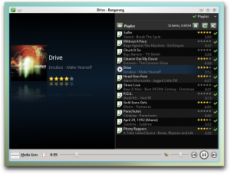 |
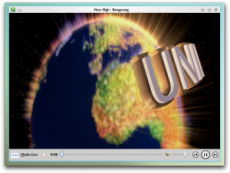 |
Basato su KDE
Bangarang è progettato per il tuo desktop basato su KDE.
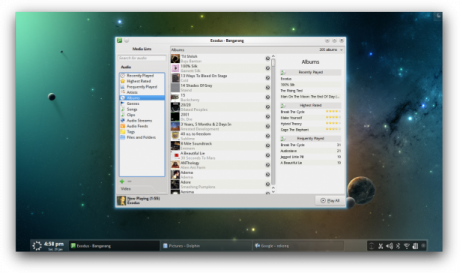 |
Completamente integrato con Nepomuk, il desktop semantico di KDE, Bangarang ha accesso alle informazioni multimediali indicizzate e condivide automaticamente le proprie informazioni multimediali, giudizi, etichette e statistiche d'uso con le altre applicazioni basate su KDE.
Tutto quello che Phonon riproduce, è riprodotto anche da Bangarang. Le impostazioni audio e video sono attivate automaticamente se il backend Phonon le supporta.
Gli oggetti desktop di Plasma con supporto MPRIS possono controllare direttamente Bangarang.
Tutto sotto controllo
Bangarang tiene sotto controllo la tua esperienza multimediale. Gli elenchi, e sono sempre a portata di mano.
La fornisce utili informazioni quando ne hai bisogno. Guarda il tuo o gli ed altro ancora, tutti aggiornati mentre sfogli.
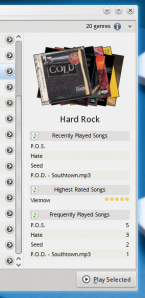 |
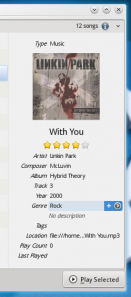 |
Modifica le informazioni multimediali facilmente. Recupera informazioni su artista, canzone, film e spettacolo televisivo da fornitori di dati liberi come Last.fm, themoviedb.org e theTVDB.com. Utilizza le Etichette per organizzare i tuoi file multimediali nel modo che desideri.
Se preferisci organizzare utilizzando file e cartelle, Bangarang ti permette di sfogliare il filesystem come qualsiasi altri elenco di file multimediali. Crea e salva elenchi di file multimediali, incluse viste continuamente aggiornate e ricerche.
Aggiungi segnalibri a qualsiasi file multimediale e ricomincia a guardare o ascoltare da dove eri rimasto.
Open Source
Bangarang, una parola giamaicana per rumore, caos e disordine, è un software open source sviluppato da volontari. Segui il blog del progetto. Se desideri partecipare contribuendo con codice, traduzioni, grafica o idee, per favore guarda la pagina del progetto e la mailing list.
Please feel free to report issues encountered while using Bangarang to the issue tracker.
Bangarang is available in the software repository of your favorite Linux distribution and from opendesktop.org. The latest version may take a few weeks after release to show up in your distributions repository. If you would like to package Bangarang for your distribution, please find the latest released source tarball here.
Tips
Editing metadata for multiple files
To edit the metadata for multiple files at once, just select the files in the the media list then click on the field in the Info View that you want to edit. When you finished editing click .
Change the album cover for all music tracks of an album
To change the album cover for all music tracks on an album, find the album and open it to show all the files. Select all the files for the album. Click on the album art in the and a file-open dialog will be presented where you can select the image file you would like to set the album image to. Make sure to click when done.
Remove the artwork for a media item
Hover the pointer over the artwork field of the Info View. Click the clear-field icon on the right to remove the artwork. Click to save the changes.
Add a bookmark to a media file you are listening to or watching
Click on the playback time display. A drop menu will appear with options to select, add or remove a bookmark. The next time you play the file a bookmark icon will appear next to the playback time indicating that bookmarks are available.
The media list shows you the same list of places as in your Dolphin Places panel. So if you have music or movies on a network share that you would like to access from Bangarang, add the network location to your Places in Dolphin and it will show up when you select in Bangarang.
Custom Recently Played, Highest Rated and Frequently Played lists
You can define criteria for the , and lists by click ![]() at the bottom of the and when any of these lists are selected.
at the bottom of the and when any of these lists are selected.
Quick filtering the media list view
If you press Ctrl + F in the view a filter bar will appear at the bottom of the list that will allow you to filter the list.
Use tags to create custom collections of your media
Every media item allows you to add your own tags. Look for the Tags field in the Info View. You can add multiple tags to any item which allows media items to belong to any tag collection. To see the audio or video tags collections choose from the selections on the left of the Media lists view. These are Nepomuk tags so they are available to the rest of the KDE desktop. This also means that if you add a tag in Dolphin, it'll show up in Bangarang.
Feel free to add more tips here.
